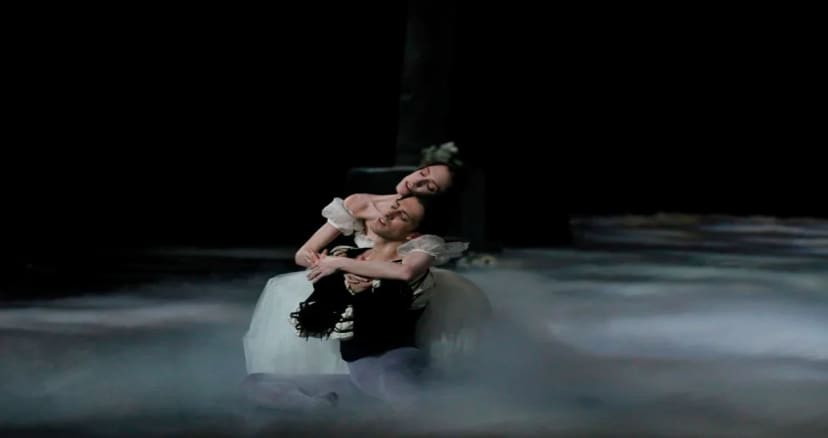Synopsis
The ultimate romantic ballet, Giselle marked the apogee of a new aesthetic that saw diaphanous tutus, white gauze, tulle and tarlatan take over the stage. The Willis bring the illusion of immateriality to this ghostly transfiguration of a tragedy. Premiered at the Royal Academy of Music on June 28, 1841, the ballet travelled to Russia, then temporarily disappeared from the repertoire before returning to France in 1910. Today’s version by Patrice Bart and Eugene Polyakov – which closely follows Jean Coralli and Jules Perrot’s original choreography – continues to reaffirm the ballet’s initial success. Bright, earthbound scenes opposed to spectral, nocturnal visions: dance becomes the language of the soul while the ethereal ballerina seems to defy gravity.
Duration : 2h00 no interval
-
Opening
-
First part 50 min
-
Intermission 20 min
-
Second part 50 min
-
End
Artists
Ballet in two acts (1841)
Creative team
Cast
- Saturday 25 June 2022 at 19:30
- Monday 27 June 2022 at 19:30
- Tuesday 28 June 2022 at 19:30
- Thursday 30 June 2022 at 19:30
- Saturday 02 July 2022 at 19:30
- Sunday 03 July 2022 at 14:30
- Monday 04 July 2022 at 19:30
- Wednesday 06 July 2022 at 19:30
- Friday 08 July 2022 at 19:30
- Saturday 09 July 2022 at 19:30
- Monday 11 July 2022 at 19:30
- Wednesday 13 July 2022 at 19:30
- Thursday 14 July 2022 at 14:30
- Friday 15 July 2022 at 19:30
- Saturday 16 July 2022 at 19:30
Latest update 17 June 2022, cast is likely to change.
Latest update 17 June 2022, cast is likely to change.
Latest update 17 June 2022, cast is likely to change.
Latest update 17 June 2022, cast is likely to change.
Latest update 17 June 2022, cast is likely to change.
Latest update 17 June 2022, cast is likely to change.
Latest update 17 June 2022, cast is likely to change.
Latest update 17 June 2022, cast is likely to change.
Latest update 17 June 2022, cast is likely to change.
Latest update 17 June 2022, cast is likely to change.
Latest update 17 June 2022, cast is likely to change.
Latest update 17 June 2022, cast is likely to change.
Latest update 17 June 2022, cast is likely to change.
Latest update 17 June 2022, cast is likely to change.
Latest update 17 June 2022, cast is likely to change.
Les Étoiles, les Premiers Danseurs et le Corps de Ballet de l’Opéra
Orchestre de l’Opéra national de Paris
Media
Access and services
Palais Garnier
Place de l'Opéra
75009 Paris
Public transport
Underground Opéra (lignes 3, 7 et 8), Chaussée d’Antin (lignes 7 et 9), Madeleine (lignes 8 et 14), Auber (RER A)
Bus 20, 21, 27, 29, 32, 45, 52, 66, 68, 95, N15, N16
Calculate my routeCar park
Parking Q-Park Edouard VII and Q-Park Meyerbeer 16 rue Bruno Coquatrix 4 rue de la Chaussée d'Antin 75009 Paris
Book your spot at a reduced priceAt the Palais Garnier, buy €10 tickets for seats in the 6th category (very limited visibility, two tickets maximum per person) on the day of the performance at the Box offices.
In both our venues, discounted tickets are sold at the box offices from 30 minutes before the show:
- €25 tickets for under-28s, unemployed people (with documentary proof less than 3 months old) and senior citizens over 65 with non-taxable income (proof of tax exemption for the current year required)
- €40 tickets for senior citizens over 65
Get samples of the operas and ballets at the Paris Opera gift shops: programmes, books, recordings, and also stationery, jewellery, shirts, homeware and honey from Paris Opera.
Palais Garnier
- Every day from 10 a.m. to 6:30 p.m. and until performances end
- Get in from Place de l’Opéra or from within the theatre’s public areas
- For more information: +33 1 53 43 03 97
Online
Palais Garnier
Place de l'Opéra
75009 Paris
Public transport
Underground Opéra (lignes 3, 7 et 8), Chaussée d’Antin (lignes 7 et 9), Madeleine (lignes 8 et 14), Auber (RER A)
Bus 20, 21, 27, 29, 32, 45, 52, 66, 68, 95, N15, N16
Calculate my routeCar park
Parking Q-Park Edouard VII and Q-Park Meyerbeer 16 rue Bruno Coquatrix 4 rue de la Chaussée d'Antin 75009 Paris
Book your spot at a reduced priceAt the Palais Garnier, buy €10 tickets for seats in the 6th category (very limited visibility, two tickets maximum per person) on the day of the performance at the Box offices.
In both our venues, discounted tickets are sold at the box offices from 30 minutes before the show:
- €25 tickets for under-28s, unemployed people (with documentary proof less than 3 months old) and senior citizens over 65 with non-taxable income (proof of tax exemption for the current year required)
- €40 tickets for senior citizens over 65
Get samples of the operas and ballets at the Paris Opera gift shops: programmes, books, recordings, and also stationery, jewellery, shirts, homeware and honey from Paris Opera.
Palais Garnier
- Every day from 10 a.m. to 6:30 p.m. and until performances end
- Get in from Place de l’Opéra or from within the theatre’s public areas
- For more information: +33 1 53 43 03 97
Online

Discover opera and ballet in another way

Dive into the Opera world and get insights on opera and pop culture or ballet and cinema. Scan this code to access all the quiz and blindtests on your mobile.

You will also like


































































































